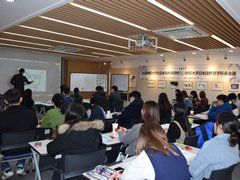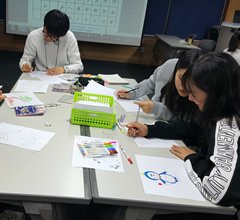Independent Initiatives Amid Difficult Circumstances
The Japan Foundation, Seoul
YAMAGUCHI Toshiyuki, OGAWA Yasuko, KAKIUCHI Ryota
1. Japanese-Language Education Training for Students at Normal Universities
Due to the impact of a rapidly declining birth rate, curriculum reform and other developments, the number of Japanese-language learners in Korea is falling, particularly in secondary education. Accompanying that, almost no Japanese-language teachers are being newly appointed, and this situation is ongoing. The number of learners is not expected to increase significantly from here on either, and with teacher training also approaching a turning point – from quantity to quality – there is a growing need for training that is targeted at “a select few.” As a way of responding to these needs, in January 2017 the Japan Foundation, Seoul (hereinafter the “Seoul Center”) held the “Japanese-Language Education Training for Students at Normal Universities” for the first time. The purpose of the program was to train the personnel who will be central to supporting Japanese-language education in the future, and it targeted university students who are enrolled at six normal universities of education throughout Korea and who are majoring in Japanese-language education.
The goal of this training was to have participants acquire more realistic and practical skills. To that end, they were introduced to the “hiragana instruction method,” which can be taught without fail in any Japanese-language education setting, along with effective methods for introducing it and communicative practice methods. Following that, they actually put what they had learnt into practice by developed their own teaching materials and teaching high school students. It was also hoped that through this Japanese-language education training, the participating students’ ambitions would be increased as a result of studying alongside students from other universities, who they do not normally have the opportunity to interact with, and that they would build strong personal networks as a result of mutually learning and supporting their classmates, who like themselves are aiming to major in Japanese-language education and work in the field.
The results of a survey carried out after the training ended suggested that the initial goal of “acquiring more realistic and practical skills” was nearly achieved, and as hoped, it appears that strong bonds were formed between the students, who share similar aspirations. In one promising comment, a student spoke of their resolve by saying “I must become a Japanese-language teacher, without fail.” We certainly hope their dream comes true and that they convey the joy of learning the Japanese language to their students while putting the experience of the training to use. Amid the rapid decline in students aspiring to be Japanese-language teachers, we at the Seoul Center intend to continue to offer training opportunities for students who continue to pursue their dream of becoming Japanese-language teachers.

A practice lesson during the university students’ training
Some happy news arrived this spring. Namely, that in the previous fiscal year three students who are currently enrolled at universities of education passed the teacher employment examination, which had included a call for Japanese-language teachers for the first time in around five years. Passing this teacher employment examination while still enrolled at university is said to be extremely difficult. We hear that there are a large number of jobless university graduates aiming to become Japanese-language teachers, and there are apparently technical colleges for such individuals. Amid that, one could assume that these three individuals’ success in the teacher employment examination will be sure to serve as powerful inspiration to the students following in their path.
2. Hiragana/Katakana Design Contest
At the Seoul Center, we have been holding the Hiragana/Katakana Graphic Design Contest (hereinafter “Kanacon”) since the fiscal year before last. The contest covers Korean secondary education venues, with students competing to produce graphic designs using Japanese letters (hiragana and katakana) as motifs. Unlike other Japanese language-related speech contests or similar events, because the graphic designs use only “kana” individuals can take part regardless of whether or not they study the Japanese language or have Japanese-language ability. The contest thus has the effect of broadly increasing interest in the Japanese language and Japanese culture. The first contest, which was held the year before last for middle school and high school students, only attracted 30 or so submissions, but last year we widened the coverage to include university students and general participants, and also placed an emphasis on PR activities. This resulted in a sudden leap in the number of submissions, to 2,700 designs. In addition to the increased submissions, the designs also showed improvement on the quality front. Surprising in particular were several works from the middle school and high school categories that were overflowing with ideas, to such an extent that they elicited the admiration of the designers who served as the external judges and reviewed the entries.

Creating “kana” graphic designs
Kanacon arose out an idea from a Japanese-language education teacher working in secondary education. A classroom activity that was created at one secondary education venue made its way outside that setting in the form of this contest, and thanks to the simplicity of the initiative, it has attracted the interest of a large number of people and grown into a major Japanese language-related event. Going forward also, we are planning to continue to hold the contest as an opportunity to encourage more people to take an interest in the Japanese language and Japanese culture, and in the interests also of invigorating the front lines of Japanese-language learning in secondary education, where the sudden decline in the number of learners has a tendency to become the sole focus.
Of the 560,000 Japanese-language learners in Korea, 450,000, or around 80%, are students who study Japanese at secondary education institutions. The environment surrounding Japanese-language learning in secondary education settings cannot be described as a good situation by any means, given that it includes everything from a declining birthrate, curriculum reform and competition with other languages (particularly Chinese), through to the relationship between Japan and Korea. However, there is no question there are more children interested in Japan and the Japanese language than we imagine. This is something we experience from children’s reactions every time we visit middle schools and high schools as one part of our secondary education support. While remaining conscious also of the needs that do not appear in these settings, we intend to continue pursuing activities aimed at encouraging more children to take an interest in Japan and the Japanese language.
(Note) The “2009 Reform of the Educational Curriculum,” (equivalent to Japan’s government guidelines for education) that was announced in 2009 was implemented in 2011, and second language subjects, including the Japanese language, were changed from compulsory subjects to elective subjects.
- What We Do Top
- Arts and Cultural Exchange [Culture]
- Japanese-Language Education Overseas [Language]
- Japanese-Language Education Overseas [Language] Top
- Learn Japanese-language
- Teach Japanese-language
- Take Japanese-Language Test
- Know about Japanese-language education abroad
- The Japanese-Language Institute, Urawa
- The Japanese-Language Institute, Kansai
- Japanese-Language Programs for Foreign Specified Skilled Worker Candidates
- Japanese Language Education for Japanese Children Resident Overseas and for the Descendants of Migrants
- Archives
- Japanese Studies and Global Partnerships [Dialogue]
- JF digital collection
- Other Programs / Programs to Commemorate Exchange Year
- Awards and Prizes
- Publications
